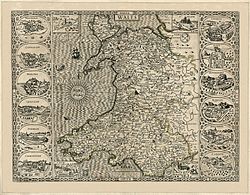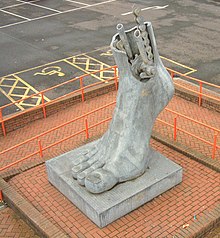| Revision as of 23:21, 31 May 2023 editDragonofBatley (talk | contribs)Extended confirmed users20,538 edits →Community: Removed WP:Original researchTags: Reverted Visual edit← Previous edit | Revision as of 09:18, 1 June 2023 edit undoPamD (talk | contribs)Autopatrolled, Extended confirmed users, New page reviewers, Pending changes reviewers, Rollbackers206,732 edits Undid revision 1157940526 by DragonofBatley (talk) let's try sourcing instead ... see next editTag: UndoNext edit → | ||
| Line 76: | Line 76: | ||
| Brian Fell's sculpture footplate<ref>{{cite web|url=http://www.pmsa.org.uk/pmsa-database/11509/|archive-url=https://web.archive.org/web/20160303220311/http://www.pmsa.org.uk/pmsa-database/11509/|url-status=dead|archive-date=3 March 2016|title=Footplate|work=National Recording Project|publisher=Public Monuments and Sculpture Association|access-date=1 August 2012}}</ref> can be seen at ]. Initially it was thought to be an imitation of the famous ] foot drawn by ]. | Brian Fell's sculpture footplate<ref>{{cite web|url=http://www.pmsa.org.uk/pmsa-database/11509/|archive-url=https://web.archive.org/web/20160303220311/http://www.pmsa.org.uk/pmsa-database/11509/|url-status=dead|archive-date=3 March 2016|title=Footplate|work=National Recording Project|publisher=Public Monuments and Sculpture Association|access-date=1 August 2012}}</ref> can be seen at ]. Initially it was thought to be an imitation of the famous ] foot drawn by ]. | ||
| The library, leisure centre (renamed in 2012 as the Jade Jones Pavilion), and the town centre have all been renovated. Flint Retail Park has also expanded and Flint is the only town in Flintshire to have a ] supermarket. | |||
| A lifeboat station was established in Flint in 1966, operated by the ].<ref>{{cite web|title=RNLI: Flint|url=http://rnli.org/findmynearest/station/Pages/Flint-Lifeboat-Station.aspx|access-date=16 February 2016}}</ref> | A lifeboat station was established in Flint in 1966, operated by the ].<ref>{{cite web|title=RNLI: Flint|url=http://rnli.org/findmynearest/station/Pages/Flint-Lifeboat-Station.aspx|access-date=16 February 2016}}</ref> | ||
Revision as of 09:18, 1 June 2023
Town and community in Flintshire, WalesHuman settlement in Wales
Flint
| |
|---|---|
 St Mary's Church, Church Street St Mary's Church, Church Street | |
 | |
| Population | 13,736 (2021) |
| OS grid reference | SJ243729 |
| Community |
|
| Principal area | |
| Preserved county | |
| Country | Wales |
| Sovereign state | United Kingdom |
| Settlements | Flint, Flint Mountain, Oakenholt |
| Post town | FLINT |
| Postcode district | CH6 |
| Dialling code | 01352 |
| Police | North Wales |
| Fire | North Wales |
| Ambulance | Welsh |
| UK Parliament | |
| Senedd Cymru – Welsh Parliament | |
| Website | flinttowncouncil.gov.wales |
| |
Flint (Template:Lang-cy) is a town and community in Flintshire, Wales, lying on the estuary of the River Dee. It is the former county town of Flintshire. According to the 2001 Census, the population of the community of Flint was 12,804, increasing to 12,953 at the 2011 census. The urban area including Holywell and Bagillt had a population of 26,442.
Geography
Flint is located in north-east Wales, adjoining the estuary of the River Dee, to the north of the town of Mold. Across the estuary, the Wirral can be seen from Flint and views to the south of the town include Halkyn Mountain. As the crow flies, Flint is located less than 12 miles from the English urban area of Liverpool, and even closer to its metro area. However, the two estuaries in between make the distance travelling on land almost twice as long.
History



The name refers to the stony platform on which the castle was built, and was first recorded in 1277 in the French form le Chaylou (cf modern French caillou, "gravel").
Edward I began to build Flint Castle in 1277, during his campaign to conquer Wales. Both castle and town were attacked by the forces of Madog ap Llywelyn during the revolt of 1294–95; the defenders of the town burnt it in order to deny its use to the Welsh.
Richard II was handed over to his enemy Henry Bolingbroke in the castle in 1399. As a consequence, it is the setting for Act III, Scene III of the Shakespeare play Richard II. The castle was the first of Edward I's 'iron ring' of royal castles to be built in Wales, and the design served as the basis for larger castles such as Harlech Castle and Rhuddlan Castle. Owain Glyndŵr unsuccessfully assaulted it at the commencement of his revolt in 1400.
The town did not have a wall, but a protective earthen and wooden palisaded ditch. The outline of this remained visible in the pattern of streets until the mid-1960s, and the medieval boundary can still be traced now. This can be seen in John Speed's map of Flintshire.
Flint Town Hall, the home of Flint Town Council, was erected in 1840.
In 1969 Flint hosted the National Eisteddfod, and so the town has a circle of Gorsedd stones in the field adjacent to Gwynedd County Primary School. In July 2006 the stones were centre stage in the National Eisteddfod Proclamation Ceremony which formally announced Mold as the 2007 host town of the event. The Urdd National Eisteddfod was held in Flint in 2016.
Governance
Flint Town Council consists of 15 councillors who are elected from four wards; 2 from Oakenholt, 3 from Castle and 5 each from Coleshill and Trelawny wards. For elections to Flintshire County Council, three councillors are elected from Flint: Coleshill and Trelawny, and one each from Flint: Castle and Flint: Oakenholt. Flint is part of the Alyn and Deeside constituency and North Wales region for the Senedd, and of the Alyn and Deeside constituency for parliament.
Culture and demography
In 2001 only 18% of the local population identified as Welsh, although this census controversially had no "Welsh" tick box.
In the census of 2011, 57.1% stated they had Welsh, or Welsh and other combined, identity. Many people in Flint have some knowledge of the Welsh language, although competence varies. Implementation of the European Union's freedom of movement provisions has led to a noticeable increase in the numbers of Polish-language speakers in Flint. Several retail businesses display information in Polish as well as in English and Welsh and the town has a number of Polskie sklepy (Polish shops) specialising in Polish products.
The Flint accent is frequently misidentified with that of Liverpool, although it has arisen in fact as a unique blending of the speech patterns of the area's Welsh speakers, earlier Irish settlers, and the residents of nearby Cheshire, Wirral, and the wider Merseyside region.
There are several songs associated with Flint. The most widely sung is "The Yard". Another popular song is "Fifty German bombers over Flint", which tells the story of a wartime bombing raid over nearby Liverpool that accidentally targeted the town of Flint instead. Verses describe the arrival of the bombers over Flint, and how they were shot down by the "Bagillt Navy". Eventually, the ill-fated German aircrew were fished out by the "Greenfield Fishers". The song is often sung in a drunken, friendly manner to the accompaniment of much hand clapping and revelry.
Transport
Flint railway station lies on the North Wales Coast Line and is served by Transport for Wales services from Manchester Piccadilly to Llandudno. A north-south service between Cardiff and Holyhead also calls, as do some Avanti West Coast services between London Euston and Holyhead. Bus services are operated by Arriva Buses Wales.
Education
The town has three high schools: St Richard Gwyn Catholic High School, Flint High School and Ysgol Maes Hyfryd. Primary schools in Flint include the Gwynedd School, Cornist Park School, Ysgol Croes Atti (Welsh medium), St Mary's Catholic Primary School and Ysgol Pen Coch.
Community

Flint once had its own low-powered television relay transmitter, designed to provide improved coverage of Welsh channels in an area that would otherwise receive only English television signals. Since 2009, signals have been transmitted digitally from Storeton transmitting station on the Wirral.
Perhaps one of the town's most striking images, in addition to the castle, is the group of three tower blocks of flats near the town centre. The first two blocks were built in the 1960s and named Bolingbroke Heights and Richard Heights, with a third, Castle Heights, added shortly afterwards.
Flint's football team is Flint Town United. They play in the Cymru Premier, the top tier of Welsh football. Nicknamed "the Silkmen", they play their home games at Cae-y-Castell.
Brian Fell's sculpture footplate can be seen at Flint railway station. Initially it was thought to be an imitation of the famous Monty Python foot drawn by Terry Gilliam.
The library, leisure centre (renamed in 2012 as the Jade Jones Pavilion), and the town centre have all been renovated. Flint Retail Park has also expanded and Flint is the only town in Flintshire to have a Sainsbury's supermarket.
A lifeboat station was established in Flint in 1966, operated by the RNLI.
Notable people
- Paul Draper (born 1970), songwriter and musician, went to school in Flint.
- Ian Puleston-Davies (born 1958), actor and writer, plays Owen Armstrong in Coronation Street.
- Julie Roberts (born 1963) painter who works in acrylics, oils and watercolours.
Sport
- Enoch Bagshaw (1884–1930), an American football player and coach.
- Ron Hewitt (1928–2001), footballer with over 500 club caps and 5 for Wales.
- Allan Jones (1940–1993), footballer with 249 caps with Brentford F.C.
- Brian Godfrey (1940–2010), footballer with over 590 club caps and 3 for Wales.
- Andy Holden (born 1963), footballer with over 170 club caps, nephew of Ron Hewitt
- Jade Jones (born 1993), 2012 and 2016 Olympic taekwondo gold medalist, attended Flint High School.
- Ian Rush (born 1961), footballer with 602 club caps and 73 for Wales, went to school in Flint; some family live in the area.
References
- in the Flint Community; aggregated from the three electoral wards
- "Y Fflint: Cynswllt a Threlawny (Flint: Coleshill and Trelawny)". UK Census Data 2021. Retrieved 10 May 2023.
- "Y Fflint: Y Castell (Flint: Castle)". UK Census Data 2021. Retrieved 10 May 2023.
- "Y Fflint: Oakenholt (Flint: Oakenholt)". UK Census Data 2021. Retrieved 10 May 2023.
- In the Flint community
- 2001 Census: Flint, Office for National Statistics, retrieved 2 August 2009
- "Town population 2011". Retrieved 25 May 2015.
- UK Census (2011). "Local Area Report – Flint Built-up area (W37000411)". Nomis. Office for National Statistics. Retrieved 21 August 2020.
- Hanks, Patrick; Hodges, Flavia; Mills, David; Room, Adrian (2002). The Oxford Names Companion. Oxford: the University Press. p. 1036. ISBN 0198605617.
- "Flint Town Hall". www.fflint.co.uk.
- National Eisteddfod Proclamation, BBC Wales, retrieved 27 August 2006
- "Oakenholt Ward". Flint Town Council. Retrieved 10 May 2023.
- "Castle Ward". Flint Town Council. Retrieved 10 May 2023.
- "Coleshill Ward". Flint Town Council. Retrieved 10 May 2023.
- "Trelawny Ward". Flint Town Council. Retrieved 10 May 2023.
- "Electoral Arrangements for Flintshire". Flintshire County Council. Retrieved 7 May 2023.
- "Census results 'defy tickbox row'". 30 September 2002. Retrieved 12 September 2021.
- UK Census (2011). "Local Area Report – Flint statistics (W04000186)". Nomis. Office for National Statistics. Retrieved 4 June 2019.
- The Voices Recordings: Male voice choir members, BBC, retrieved 27 August 2006
- "BBC - North East Wales Flintshire history - Flint songs". Archived from the original on 17 July 2011. Retrieved 16 October 2010.
- "Wales Railway Map and Train Routes". TfW. Retrieved 10 May 2023.
- "May 2023 to December 2023 timetable book" (PDF). Avanti West Coast. p. 19–27. Retrieved 10 May 2023.
- "Footplate". National Recording Project. Public Monuments and Sculpture Association. Archived from the original on 3 March 2016. Retrieved 1 August 2012.
- "RNLI: Flint". Retrieved 16 February 2016.
- Press Office: Ian Puleston-Davies, Funland, BBC, retrieved 25 March 2008
External links
- BBC Wales's Flint website
- www.cefnpennar.com : Flint historical & genealogical records list
- www.geograph.co.uk : photos of Flint and surrounding area
- Clwyd-Powys Archaeological Trust - Flint in the prehistoric, Roman and early medieval periods
